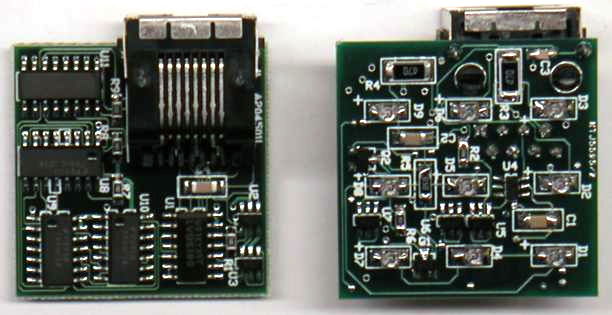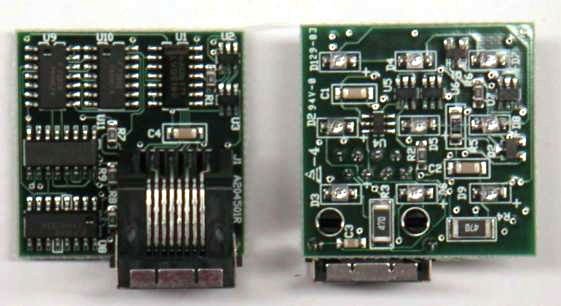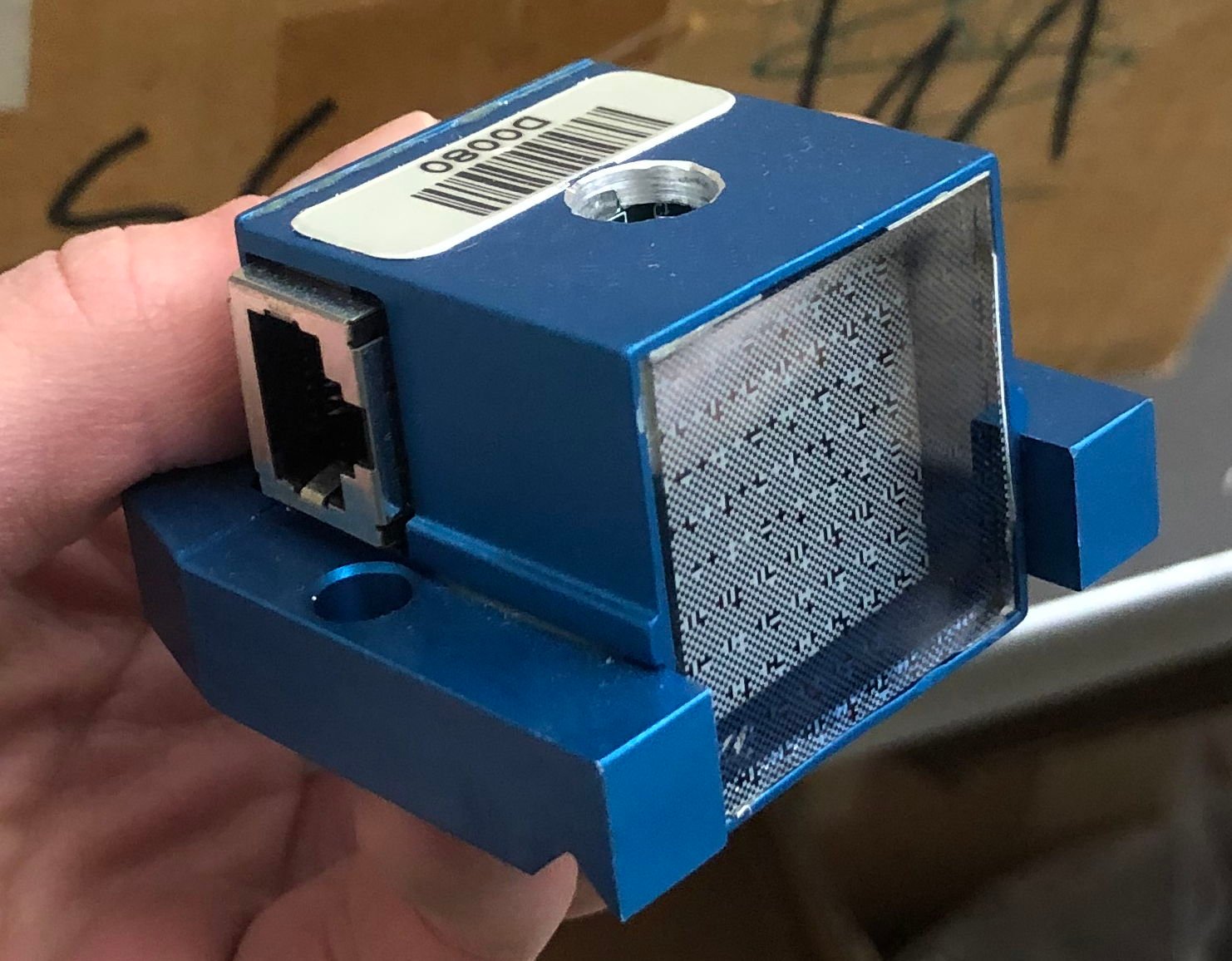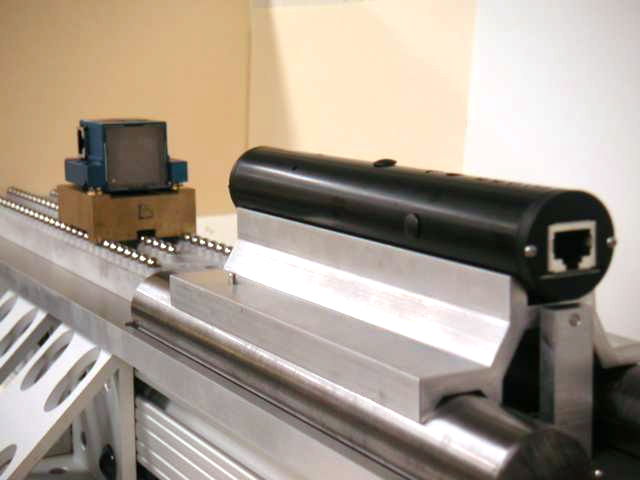[15-APR-21] The Proximity Mask Head (A2045) is a Long-Wire Data Acquisition (LWDAQ) Device that drives nine infrared light-emitting diodes (IR-LEDs). A LWDAQ command with DC1 set will turn on the LEDs, and any command with DC1 cleared will turn off the LEDs. The A2045 is LWDAQ device type LED (1).

The A2045 uses the same circuit as the A2052. Instead of mounting with three snap-top standoffs, as does the larger A2052 board, the more compact A2045 mounts by gluing it onto a rectangular flange that fits around the bottom side of the board.

The proximity masks consists of one A2045 circuit board, an aluminum enclosure with kinematic mounting sockets, a rasnik mask, and an opal glass diffuser to spread the light of the nine LEDs across the surface of the rasnik mask. A screw holds the mask onto its three-ball kinematic mount.

When glued into an enclosure, most of the A2045 assemblies we installed in the ATLAS end-cap alignment system will over-heat if left on for more than ten seconds. Twenty-four hours of continuous operation is likely to damage the circuit, as described below. This over-heating is the result of miscalculations in our original design. We correct the eror by changing increasing resistor R3 from 47 Ω to 100 Ω.
The A2045 is complies with the LWDAQ Specification. It is LWDAQ Device type 1 for the purpose of device-dependent jobs. The LED driver is element number 0 or 1. Command bit allocation is as follows.
| DC16 | DC15 | DC14 | DC13 | DC12 | DC11 | DC10 | DC9 | DC8 | DC7 | DC6 | DC5 | DC4 | DC3 | DC2 | DC1 |
|---|---|---|---|---|---|---|---|---|---|---|---|---|---|---|---|
| X | X | X | X | X | X | X | X | X | LB | X | X | X | X | X | ON |
The A2045 ignores DC8, which is normally the WAKE bit for LWDAQ devices. But the A2045 has only two states: off or on. The off state is equivalent to the usual sleep state.
Look here for the Functions section of the A2052 manual, which applies also to the A2045.
Look here for the Operation section of the A2052 manual, which applies also to the A2045. The figure below is a picture of a Proximity Mask being viewed by a Proximity Camera. The Blue Proximity Mask uses the A2045R. The Black Proximity Mask uses the A2045L.

We picked an A2045R at random and measured its power consumption in two states.
| State | +15 V | -15 V | +5 V |
| Off | 0.3 mA | 0.3 mA | 0.7 mA |
| On | 80 mA | 80 mA | 1.0 mA |
Later, however, we found that the A2045Ls we made had the following power consumption, as well as our A2052As and A2045Rs.
| State | +15 V | -15 V | +5 V |
| Off | 0.3 mA | 0.3 mA | 0.7 mA |
| On | 110 mA | 110 mA | 1.0 mA |
See below for the implications of these changes in active current consumption.
We intended the the A2045 (and also the A2052) to pass 80 mA through its nine LEDs. The HSDL-4400 LED's maximum continuous forward current is 100 mA. We wanted to operate below the maximum, in order to extend the life of the diodes. With the R5 equal to 22 Ω as shown in the schematic, the circuit does pass 80 mA through the LEDs. But the 1400 A2045s and 1200 A2052s we made for ATLAS had R5 equal to 15 Ω, and so passed 110 mA through the LEDs. This higher current will, no doubt, reduce the operating lifetime of the LEDs.
Not only did the ATLAS circuits pass too much current through the LEDs, they also allowed too much power to be dissipated in transistor Q1. Resistors R3 and R4 were only 47 Ω, instead of the 75 Ω we show in the schematic. Transistor Q1 has 8 V across it instead of 1.7 V. It must dissipate 800 mW instead of 200 mW. The transistor is designed to dissipate only 500 mW. Twenty-four hours of continuous operation (as described here) is enough to damage this transistor in either the ATLAS A2045s or the ATLAS A2052s.
Most damaged circuits can still flash its LEDs brightly, but not for longer than a few seconds. If we turn on the LEDs, their power output remains steady for several seconds, flickers, and drops to roughly 1% of its previous value. If we hold the board vertically, and blow on it to keep it cool, the LEDs might keep shining at 100% power for a minute, but eventually flicker and turn off. If remove power from the circuit and wait for a full five minutes, we find that the circuit has recovered, and will drive the LEDs at 100% power for a few seconds once again.
The remaining damaged boards cannot drive their LEDs at 100% power at all. Instead, they drive them at 1% power.
If we replace Q1 in any of these damaged circuits, the board is as good as new. We do not claim to understand this transistor failure, but we that is what we observed in all five broken A2045s returned from CERN, and all three broken A2052s from our demonstration stand.
The LWDAQ specification requires that no LWDAQ device can be damaged by any sequence of command transmissions. The A2045 in an enclosure can be damaged simply by turning it on and leaving it on. This does not happen in normal operation, but does occur after power supply surges that cause its command register (U11) to re-start in an undefined state. Random power surges at CERN appear to have left Proximity Mask Heads (A2045L and R) turned on until Q1 fails. When we received such boards back from CERN, we replaced Q1 and they worked again.
We will explain, for those who are curious, how our circuit design went wrong. (Please refer to the schematic for part names.) Resistor R5 controls the current through the LEDs. In the ATLAS circuits, it was 15 Ω. The three diodes of U7, a MA125, pass of order 1 mA, and we supposed they would drop 0.6 V each, or 1.8 V total. The base-emitter drop of PNP transistor Q1, a FMMT591A, will be roughly 0.8 V at the LED operating current. This leaves 1.0 V across R5. The ATLAS circuits had R5 of 15 Ω, so we anticipated 75 mA through the LEDs. But it turns out that the diodes of U7 have a total drop of closer to 2.1 V, and Q1 at 100 °C has a base-emitter drop of only 0.4 V at 100 mA. We are left with 1.7 V across R5 instead of our anticipated 1.0 V, and the LED current is 110 mA.
With 110 mA flowing through the LEDs, and 47 Ω for R3 and R4, these two resistors together drop only 10.3 V of the 30 Volts available from the ±15-V supplies. The HSDL-4400 LEDs themselves have a typical forward voltage drop of 1.5 V at 50 mA, and this is what we observed in our prototype circuits. But the LEDs we used in our A2045 and A2052 boards have forward voltage drop of only 1.3 V at 110 mA. We are left with 30 − 10.3 − 1.7 = 6.3 V across Q1, and 110 mA, or a total power dissipation in its SOT-23 package of 700 mW, well above its maximum continuous dissipation in free air of 500 mW.
The lower than expected drop across the LEDs, combined with our errors in designing the current source, cause excessive power dissipation in Q1. It is too late for us to modify our ATLAS A2045s, but if you want to make some more, we recommend that you use the resistor values shown in the schematic, where we R5 is 22 Ω, and R3 and R4 are 75 Ω. If you have a circuit with R5 of 15 Ω and R3 and R4 of 47 Ω, the quickest way to fix it is by changing R3 to 100 Ω. This change will reduce the voltage across Q1 from 6.7 V to 1.7 V, and so avoid overheating. We applied this change to hundreds of existing Inplane Mask Heads (A2052). The modified boards suffered no damage from over-heating even after continuous operation for 200 hours, as described here.
We provided approximately 1400 A2045s for the ATLAS experiment, as well as 1100 A2052s. The A1052 circuit is identical to that of the A2045. The following table lists the errors we found on boards returned by our colleagues at CERN and marked as malfunctioning in some way.
| Frequency | Problem |
|---|---|
| 4 | passes all tests |
| 1 | burned-out power resistors |
| 10 | mechanical damage, cracked power resistors |
| 1 | mechanical damage, shattered LEDs |
| 4 | Q1 burned out, 1% power or short 100% flashes |
The A2045 uses the same differential transceiver, clamping diodes, power supply switches, regulator, and logic chips as the Proximity Camera Head (A2047). For a discussion of the radiation tolerance of these components, see here. The LEDs on the A2045 are vulnerable to neutron radiation, as we describe in Pre-Production Radiation Tests. We observe a 90% loss of power after 1012 1-MeV eq. n/cm2 neutron dose. (Our estimated maximum ATLAS dose is around 0.8 Tn at full luminosity for ten years.) We observe no loss in power after 40 krad of ionizing radiation.
Note: All our schematics and Gerber files are distributed under the GNU General Public License.
Here is the A2045 circuit diagram.
Receiver and LED DriverHere are the two available printed circuit board layouts.
A204501L for A2045L